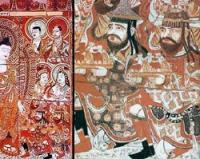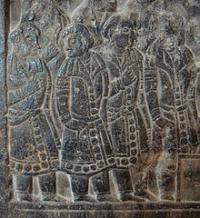You are here
Silk Road. Sogdian Principality.


Great Silk Road in Central Asia.
“We leave something of ourselves behind when we leave a place, we stay there, even though we go away. And there are things in us that we can find again only by going back there”
Pascal Mercier. «Night Train to Lisbon».
Tours of Great Silk Road in Uzbekistan.
In the IVth – VIIIth centuries, the Sogdians became major dealers in trade operations among Far East, Central Asia and Near East. They set regular caravan trade on the Great Silk Road. Sogdian trading colonies were operating along all the way from Central Asia to China.
Ancient Sogdian letters, found in China near Dunchuan, testify that rich families from Samarkand, Paikend and some other Sogdian cities financed trade operations in far colonies. In Sogdian midst, skill in trade and leaning to far voyages were educated from childhood.
The chronicle of Tang dynasty informs that the Sogdians smeared a tongue of newborn boy with honey and “put glue on palms to make him mealy-mouthed and strongly held coins". At that time, Sogdian language became lingua franca of the Great Silk Road.
Buddhists, Christians and Manicheans translated their religious texts into Sogdian. The most spread was Sogdian written language based on Aramaic alphabet, later adapted by the Uigurs.
International trade caused a new heyday of Samarkand. Shahristan was extended and encircled by four lines of new walls from adobe brick. The last wall was 10 - 12 meters high. Each of twelve town gates formed a small fortress.
The eastern gates of Samarkand were "Chinese". In the city there were Zoroastrian temples, cultic structures of Buddhists and Christians. Samarkand became one of the strongest principalities in Sogd, which in the Vth – VIth centuries, recognized dominion of the Hephthalites, and later, in the VIth – VIIth centuries – of the Turkic chaganate.
Sogdian merchants succeeded to obtain protection of some nomadic dynasties on northern trade routes from China to Byzantium. The history has kept evidence for the embassy of Sogdian merchant Maniachus, sent in the 560s - 570s by Turkic chagan to Byzantium for establishment of allied and commercial relations round about hostile Sassanian Iran.
In the 630s, the Sogdians recognized supremacy of Chinese dynasty Tang.
From the mid-7th, Samarkand governor - ihshid headed the confederation of Sogdian principalities. Political orientation to China caused minting of coins with square holes after Chinese tradition.
Chinese pilgrim Xuan Zang informed that Samarkand was populous trading city, where warehouses were full of valuable goods from foreign countries, and citizens much surpassed their neighbours in arts, crafts and trade.
The Chinese chronicles inform that in the IVth – VIIth centuries the mountains southward from Samarkand were rich in lions, which were regularly delivered to the court of the Chinese emperor.
By the VIIth - VIIIth centuries, the Sogdians had adapted Chinese secrets of silk raising so well, that Sogdian silk fabrics almost completely replaced export of Chinese silk to Western Europe. In its own turn, thanks to the Sogdians, China obtained knowledge in flax and wool processing, carpet and tapestry making, traditionally well developed in Central Asia.
Authority:
Alexey Arapov. Samarkand. Masterpieces of Central Asia. Tashkent, Sanat. 2004.






